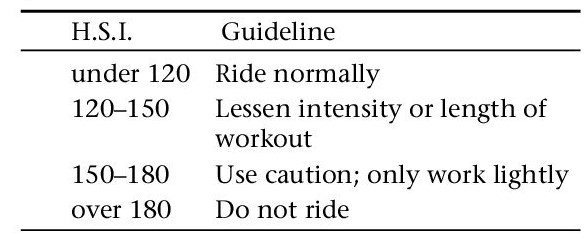Weather and your horse
Extreme weather conditions put stress on a horse and can affect its health. You need to know what problems to look for in summer and winter and how to prevent those problems.
Cold Weather Care
When the weather turns cold, you’ll need to make adjustments to your horse’s routine care. Though you may not enjoy spending time in the cold and wet, remember that your horse is depending on you to keep it healthy.
Shelter
Your horse must have shelter where it can dry off each day and be out of the wind. If your horse has proper shelter, its winter hair coat will generally keep it warm enough. The hairs grow downward to make an insulating layer of air. When the horse gets cold, special muscles make the hair stand up, which increases the air layer and the insulation. A horse produces more body oils in the winter, which help the coat shed water. So, if the horse is dry and out of the wind, it can stand subfreezing temperatures easily.
But when the horse gets wet, its hair flattens, and the insulating air layer is lost. Wet hair also conducts heat away from the horse’s body faster than dry hair, which may cause the horse to get cold. If your horse is shivering, has a tense body or clamped tail, or its ears feel cold, it is probably too cold.
Wind also affects the insulating air layer in a horse’s coat by blowing the hairs apart. This greatly increases the loss of body heat. Wind is often more of a problem than rain. A horse can stand being in the rain for awhile as long as the wind is not blowing.
While shelter is important, be sure your horse is not shut up in an airtight, heated barn. Such a place is a haven for dust, molds, and ammonia fumes, all of which are extremely harmful to the horse’s health. The horse must have fresh air, or it runs a high risk of developing respiratory problems.
Feeding
In cold weather, a horse needs more energy to keep warm, so its nutritional needs increase. Feeding your horse properly during winter not only prevents weight loss and loss of conditioning, but helps prevent colic and laminitis. A general rule of thumb is to increase the feed ration 10 percent for each 10°F below freezing.
A common mistake is to increase the amount of grain, but a horse needs more forage in cold weather, not more grain.
The fermentation of forage during digestion produces more and longer-lasting heat than that produced from the digestion of grain. Therefore, giving your horse more hay will help it keep warm, but feeding it extra grain will not.
Horses often are not worked as hard in the winter, so they do not use as much energy.
Since grains are generally high in carbohydrates (the source of most energy), you must decrease the amount fed or your horse may become too energetic and less manageable. The common term for this is hot.
If your horse has a thick winter coat, it is important to monitor its weight closely. It is often hard to tell through all the hair if the horse is losing weight. Once a week, feel for its ribs.
Remember that adequate salt intake is just as important in cold weather as in the summer.
Watering
Wintertime watering can be a challenge. A cold horse does not like to drink cold water and may drink very little if the water is icy. Though they are not losing water from sweating, horses still need plenty of water. Two common results of a horse’s not drinking enough are dehydration and impaction colic.
Make sure your horse gets enough to drink by providing clean, fresh water free of ice.
Inexpensive stock tank heaters can keep your water ice-free (be sure to protect the cord from chewing). It also helps to remove any chunks of ice from water sources and add hot water to buckets to warm the water already there.
Do not expect your horse to get water by eating snow. A horse would have to eat about six buckets of snow to equal drinking one bucket of water. Even if there is lots of snow around, you must still provide drinking water.
Blanketing
Most horses do not need to be blanketed. A normal horse’s winter coat keeps it as warm as a top-quality blanket. In fact, blankets may be counterproductive. The weight of the blanket flattens the hair, eliminating the air layer and the horse’s natural insulation.
One of the main concerns with blankets is overheating. If the horse gets too warm, it sweats under the blanket and becomes wet. This can lead to chills and illness.
If you choose to blanket, change blanket weight with changes in temperature, both from day to night and from day to day. It is always better that a blanket be too light than too heavy. Check for overheating by feeling for sweat under the blanket near the girth and the flank.
Often people blanket their horse more as a convenience to them than as a help to the horse. Make sure you have a good reason for keeping your horse blanketed all winter.
When deciding whether or not to blanket your horse in the winter, take the following into account:
Horse’s condition. A healthy, conditioned horse is less likely to need blanketing. An older horse, an underweight horse, or a horse with a health problem may require blanketing.
Horse’s activity level. If your horse is not being ridden much during the winter, don’t blanket it. If you are riding daily or showing, you may want to clip the horse, in which case you must blanket it.
Facilities. If your horse has adequate shelter, it probably doesn’t need a blanket. The more exposure your horse has to wind and rain, the more likely it will need a blanket.
Expense. Blankets are expensive. To blanket your horse properly, you will need several blankets of different weights.
Your time commitment. Keeping your horse blanketed takes a lot of work.
Because blankets flatten the horse’s hair, you should groom the horse daily to stir the hair back up. You should remove and readjust blankets at least once each day to check for areas of rubbing, hair loss, or sores. Replace wet turnout blankets with dry ones. Never stall a horse in a wet blanket. Check blankets for damage daily, and clean them several times a year.
All of these things take time. If you cannot commit to changing your horse’s blanket at least once a day, you should not blanket at all.
Exercise
Even in winter, daily exercise is important.
Horses often are turned out and ridden less in winter. This makes them very energetic when they are turned out, especially if their grain ration has not been reduced. Horses can hurt themselves if they are too rambunctious, pulling muscles and tendons.
Make sure your horse gets some exercise each day. Warm it up slowly to loosen muscles. The colder the weather, the longer it takes to warm up adequately.
Even more important than the warm-up time is properly cooling the horse down after the workout. In winter, a horse needs to be cooled down gradually and completely to avoid the risk of chills. If the horse is sweaty, rub its coat with a towel to fluff the hair. Keep the horse moving until its hair is dry and its body temperature has returned to normal. If the blood vessels narrow too rapidly, cramps can develop. On the average, during the winter, half of your workout time should be spent cooling the horse down.
If you are riding outside during the winter, remember that footing is often slippery. Frozen ground is hard and can cause bruises to the horse’s sole. Abscesses are more common in the winter mud. Snow can pack in shoes, causing lameness. Check your horse’s feet often.
Hot Weather Care
Four common heat-related health problems are dehydration, heat stroke, thumps, and sunburn.
Dehydration
Dehydration occurs when the horse does not drink enough water to supply its needs. Signs of dehydration include dry, hard feces; dark yellow, opaque urine; and lethargy. In severe cases, colic can occur. The horse may stop sweating, collapse, or die. A slightly dehydrated horse may show few symptoms and be fine if it drinks water. A moderately dehydrated horse may need electrolytes along with water, while a severely dehydrated horse needs veterinary care and may require intravenous (IV) fluids.
To test for dehydration, pinch 1 to 2 inches of skin on the horse’s neck, forward of the shoulder. When you let go, the skin should immediately snap back. If it doesn’t, the horse is dehydrated. You also can check for dehydration by testing the capillary refill time (CRT). Apply pressure to a spot on the horse’s gums for a few seconds. The gum will turn white. When you release the pressure, the gum should return to a pink color within 2 seconds.
Heat Stroke
Heat stroke is a serious, often fatal, condition. Signs include hot, dry skin; refusal to move; an increase in the pulse and respiratory rates; weakness; and a temperature of 106 to 110°F. Act immediately; it is essential to lower the horse’s body temperature quickly. Call the veterinarian, hose the horse with cold water, and get the horse in the shade. If there is no breeze, cool the horse with a fan.
Thumps
Thumps is the common name for synchronous diaphragmatic flutter (SDF), a rhythmic spasm in the flank that twitches in time with the heartbeat. SDF is a sign that the horse is severely dehydrated and low on electrolytes. Immediate treatment is needed. In mild cases, rehydrating the horse and cooling it off will stop the spasms. In more severe cases, a veterinarian may need to administer IV fluids.
Sunburn
Appaloosas, Paints, and blaze faces commonly suffer from sunburn, but any pink- skinned areas are vulnerable. Prevent sunburn by keeping horses in during the middle of the day, covering them with a light sheet, or using a sunblock lotion.
Prevention
To avoid heat-related health problems, you may need to shorten the length of your ride, lower the intensity of the workout, or ride early in the morning or late in the evening when it is cooler. The more in shape your horse is, the less likely it is to suffer from the heat. In particular, make sure your horse is not overweight.
The primary way a horse controls its body temperature is by sweating and sweat evaporation. Humid weather reduces the evaporation of sweat. When planning your riding activity, it is as important to consider humidity as temperature. Use the Heat Stress Index (H.S.I.) to help plan your workouts.
To find the H.S.I., add the temperature to the percent of humidity. (For example, if the temperature is 80°F and the humidity is 30%, the H.S.I. would be 110.) Once you have determined the H.S.I., use the following guidelines:

It is commonly thought that you should not let a hot horse drink water, but dehydration is a much more serious problem than what might happen if a horse drinks while hot. Just be sure that the water is not icy cold, as this may cause colic. Room-temperature water is safe for the horse to drink.
If your horse is extremely hot after a ride, don’t be afraid to hose it off with cold water. This does not cause cramping, but cools the muscles and prevents overheating. When you are done hosing, be sure to scrape the water off. If left on the horse, the water quickly heats and causes the horse to become hotter. Walk the horse until it is dry and cool. The slight breeze generated by walking can help sweat evaporate.
When a horse sweats, it loses essential salts and minerals in addition to water.
These electrolytes are essential for the proper functioning of muscles and heart. Electrolyte supplements can be added to a horse’s water, but the horse must drink enough water for the supplements to work. Also, too many electrolytes can cause as many problems as too few, so make sure your horse needs a supplement before you use one. Most veterinarians recommend that only horses in a rigorous work schedule be given electrolyte supplements routinely.








